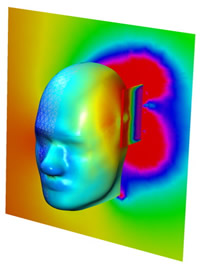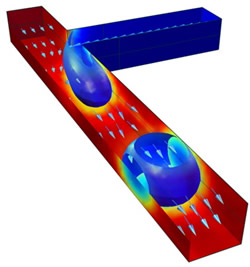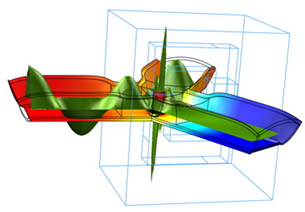COMSOL Multiphysics 3.4 Speeds Up Multiphysics Simulations
Major upgrade leverages multicore processors and shared-memory parallelism.
October 17, 2007
By DE Editors
 Self-contact in the boot seal of a gear stick. The figure shows the total displacement. |
COMSOL, Inc. (Burlington, MA) announced COMSOL Multiphysics 3.4, a new release of its engineering and scientific software environment for modeling and simulating any physics-based system. New multicore processor support provides engineers and scientists with “unprecedented performance, solver speed, and accuracy in multiphysics simulations,” states the company in a press release.
COMSOL Multiphysics 3.4 will use the maximum number of cores available on the system, and users have complete control over the number of processors dedicated to their simulations, thereby upping the computational speed by leveraging multicore processors and shared-memory parallelism. Every step of the simulation workflow—meshing, assembly, and solving—now executes in parallel.
“COMSOL 3.4 leverages multicore processors to deliver best-in-class multiphysics simulation performance on standard dual-core, quad-core, and multicore PCs,” explains Bernt Nilsson, VP of Marketing at COMSOL, Inc. “COMSOL’s speed and accuracy stand out as superior in independent benchmark studies.” Studies were run at the University of Nevada, Las Vegas, comparing COMSOL with a number of other FEA-based simulation tools in a range of multiphysics applications.
“COMSOL 3.4 leverages multicore processors to deliver best-in-class multiphysics simulation performance on standard dual-core, quad-core, and multicore PCs.” — Bernt Nilsson, COMSOL, Inc., VP of Marketing |
In addition to applying parallel computing throughout the solution process, COMSOL Multiphysics 3.4 introduces new fluid dynamic solver methods for simulating very large problems in chemical engineering, heat transfer, or microfluidics applications. More enhancements in the suite of discipline-specific modules handle specialized simulations for chemical engineering, RF, reaction engineering, and structural mechanics.
A major upgrade to COMSOL Multiphysics’ iterative methods pushes solver performance for fluid dynamics to new heights. For example, Galerkin Least Squares (GLS) stabilization techniques now complement COMSOL’s iterative solvers, enabling engineers and scientists to compute large fluid flow problems with millions of degrees of freedom. A segregated solver with an easy-to-use interface, new in version 3.4, reduces memory consumption significantly when computing large problems, such as fluid-structure interaction (FSI) or wave propagation in thermally deformed structures. When compared to its predecessors, COMSOL Multiphysics 3.4 solves fluid-flow problems up to five times faster.
COMSOL Multiphysics 3.4 also offers users new postprocessing tools for computing geometric properties such as volume, area, center of gravity, and moment of inertia. Simulation results can be presented in new ways using an expanded palette of color scales.
Users of the COMSOL Chemical Engineering and Heat Transfer Modules can now step up their simulations to include variable-density flow and free convection. Engineers will find these new capabilities useful when solving coupled flow and conjugate heat transfer problems frequently encountered in electronic cooling and heat exchanger analyses. For applications such as microfluidics, multi-species convection, and reacting flows, COMSOL Multiphysics 3.4 offers additional multiphysics modeling interfaces for turbulent and laminar flow with variable densities due to variations in composition.
The Chemical Engineering Module has been improved with a powerful modeling interface for the simulation of multiphase flow. With it, users can simulate bubbly flows in scrubbers, aerators, bioreactors, and food-processing equipment effortlessly. Users can also easily set up mixture models for simulating emulsification, sedimentation, and other separation processes common in the chemical, pharmaceutical, and food-processing industries.
 RF heating through the absorbed radiation in human tissue. This multiphysics analysis shows a slice and boundary plot of Specific Absorption Rate (SAR) value resulting from the radiation emitted by a mobile phone. |  Multiphase flow analysis of droplet breakup in a T-junction. This is used in emulsification processes such as in the production of food, cosmetics, and pharmaceutical products. |
The Heat Transfer Module has been enhanced by the introduction of boundary layer meshing and by improvements to COMSOL’s solver technology. Boundary layer meshing provides engineers and scientists with greater accuracy yet requires fewer elements for simulating electronic cooling, heat exchangers, and heat losses to solid structures in mechanical design. Also new in the Heat Transfer Module is the ability to model 3D surface-to-surface radiation using memory-saving 2D axisymmetric modeling domain.
Upgrades to the COMSOL Reaction Engineering Lab include a new interface for running nonlinear parameter estimations on multiple sets of experimental data. It is now possible to select which parameters to estimate and which parameters to keep constant in each estimation run. Outputs display intervals and standard deviations.
Version 3.4 makes it easy to build and run COMSOL models as part of SPICE-based circuit simulations due to the AC/DC Module’s new SPICE user interface. Another new feature for electronics, electrical components, geophysics, and electrochemistry applications is small-signal analysis for AC impedance studies. Users can model electric motors and generators through a new interface supporting periodic boundary conditions and sector symmetry; it is found in the RF Module along with an improved interface for lumped port boundary conditions suited for wave propagation in transmission lines and circuit boards.
 Thermal-structural-electromagnetics multiphysics coupling in a microwave circulator. |
The COMSOL Multiphysics Structural Mechanics Module lets users predict high- and low-cycle fatigue damage. A suite of COMSOL Script functions calculates fatigue damage from inputs made up of loading data and deterministic, stochastic, or even nonproportional material fatigue data.
Other highlights of COMSOL Multiphysics 3.4 offer memory-efficient fluid flow solvers for chemical engineering, heat transfer, and microfluidics; segregated solver to minimize memory consumption for large multiphysics problems; easy modeling of electronics cooling and free convection with interfaces for variable-density flow; mixture-model two-phase flow interfaces for simulation of emulsification, sedimentation, separation processes, and fluidized beds; nonlinear parameter estimation; piezoacoustic multiphysics modeling of microphones, ultrasonic transducers, and MEMS devices; and full-wave 3D RF analysis of printed circuit boards and transmission lines with lumped port boundary conditions.
Pricing for COMSOL Multiphysics 3.4, which runs on Windows, Linux, Solaris, and the Macintosh workstations with a minimum of 1GB of memory, starts at $7,995 (US). Please use the links below for further information.
Click here for details about COMSOL Multiphysics 3.4, discipline-specific technology modules, and detailed system requirements.
Click here to see What’s New in COMSOL Multiphysics 3.4.
Click here for COMSOL’s image gallery.
Click here for COMSOL’s updated 2008 product catalog.
Click here to sign up for an introductory CD on COMSOL Multiphysics.
Subscribe to our FREE magazine, FREE email newsletters or both!
About the Author
DE’s editors contribute news and new product announcements to Digital Engineering.
Press releases may be sent to them via [email protected].






